Indgo Solar Specially designed an electric rickshaw (E-rickshaw) is designed to provide additional power to the battery of the vehicle using solar energy. E-rickshaws are typically battery-operated vehicles used for short-distance transportation in urban and rural areas. Indgo Solar panel for an E-rickshaw is an array of photovoltaic cells that convert sunlight into electricity. It is mounted on the roof or structure of the E-rickshaw to capture sunlight and generate power. This generated electricity is then used to charge the vehicle’s battery, extending its range and reducing the need for external charging.
Features:
Solar Energy Harvesting:
The primary purpose of the solar panel is to harvest solar energy and convert it into electricity. This supplemental power can reduce the reliance on grid charging and increase the vehicle’s overall efficiency.
Roof Integration:
Indgo Solar panels for E-rickshaws are designed to be integrated into the roof or structure of the vehicle, maximizing the surface area available for solar energy capture.
E-rickshaw Solar Panel Size:
Indgo E-rickshaw Solar panels come in 545 watts size and configurations to match the available roof space on all E-rickshaw models.

Description
Indgo Solar Specially designed an electric rickshaw (E-rickshaw) is designed to provide additional power to the battery of the vehicle using solar energy. E-rickshaws are typically battery-operated vehicles used for short-distance transportation in urban and rural areas. Indgo Solar panel for an E-rickshaw is an array of photovoltaic cells that convert sunlight into electricity. It is mounted on the roof or structure of the E-rickshaw to capture sunlight and generate power. This generated electricity is then used to charge the vehicle’s battery, extending its range and reducing the need for external charging.Features:
Solar Energy Harvesting:
The primary purpose of the E-Rickshaw Solar Panel is to harvest solar energy and convert it into electricity. This supplemental power can reduce the reliance on grid charging and increase the vehicle’s overall efficiency.Roof Integration:
Indgo E-Rickshaw Solar Panel for are designed to be integrated into the roof or structure of the vehicle, maximizing the surface area available for solar energy capture.E-rickshaw Solar Panel Size:
Indgo E-rickshaw Solar panels come in 545 watts size and configurations to match the available roof space on all E-rickshaw models.
Power Output:
The output power of a solar module is measured in watts (W). Indgo E-rickshaw solar panels typically have a power output that ranges from 450 watts to 545 watts, depending on the size and efficiency of the panel.
Lightweight Design:
Indgo Solar panels used for E-rickshaws are designed to be lightweight to minimize the impact on the vehicle’s weight and performance.
Durability:
Indgo Solar panels for E-rickshaws are designed to withstand outdoor conditions, including exposure to sunlight, rain, and dust. They are often made with materials that are weather-resistant and UV-stable.
Efficiency:
The efficiency of a solar module refers to how effectively it converts sunlight into electricity. Indgo Solar higher efficiency panels can generate more power for the same amount of sunlight exposure.
Charging Assistance:
Indgo Solar panels provide a supplementary source of power to the vehicle’s battery, which can extend the range between regular charges and reduce the frequency of grid charging.
Reduction in Operating Costs:
By Indgo solar panel through harnessing solar energy, E-rickshaw owners can reduce their operational costs by relying less on grid electricity for charging.


Power Output:
The output power of a solar module is measured in watts (W). Indgo E-rickshaw solar panels typically have a power output that ranges from 450 watts to 545 watts, depending on the size and efficiency of the panel.Lightweight Design:
Indgo E-Rickshaw Solar Panel used for E-rickshaws are designed to be lightweight to minimize the impact on the vehicle’s weight and performance.Durability:
Indgo E-Rickshaw Solar Panel for are designed to withstand outdoor conditions, including exposure to sunlight, rain, and dust. They are often made with materials that are weather-resistant and UV-stable.Efficiency:
The efficiency of a solar module refers to how effectively it converts sunlight into electricity. Indgo Solar higher efficiency panels can generate more power for the same amount of sunlight exposure.Charging Assistance:
Indgo E-Rickshaw Solar Panel provide a supplementary source of power to the vehicle’s battery, which can extend the range between regular charges and reduce the frequency of grid charging.Reduction in Operating Costs:
By Indgo E-Rickshaw Solar Panel through harnessing solar energy, E-rickshaw owners can reduce their operational costs by relying less on grid electricity for charging.Environmental Benefits:
Indgo Solar panels contribute to reducing the carbon footprint of E-rickshaws by utilizing clean and renewable energy.
Integration with Battery Management:
Indgo Solar panels and charge controller can be integrated with the E-rickshaw battery management system to ensure efficient charging and prevent overcharging.
Enhanced Marketing:
E-rickshaws equipped with Indgo Solar panels can be marketed as eco-friendly and energy-efficient, potentially attracting environmentally-conscious customers.
Easy Installation:
Indgo Solar panels can be relatively easy to install on E-rickshaws, with appropriate mounting brackets and wiring.
Low Maintenance:
Indgo Solar panels require minimal maintenance, usually limited to periodic cleaning to ensure optimal energy capture.
Aesthetic Integration:
Indgo Solar panels can be designed to blend with the overall aesthetics of the E-rickshaw, enhancing its visual appeal. Indgo solar panels for E-rickshaws offer a practical way to harness solar energy and extend the vehicle’s range while reducing operating costs and environmental impact. They are designed to be lightweight, durable, and efficient, providing a valuable solution for the growing market of electric transportation.

Environmental Benefits:
Indgo E-Rickshaw Solar Panel contribute to reducing the carbon footprint of E-rickshaws by utilizing clean and renewable energy.Integration with Battery Management:
Indgo E-Rickshaw Solar Panel and charge controller can be integrated with the E-rickshaw battery management system to ensure efficient charging and prevent overcharging.Enhanced Marketing:
E-rickshaws equipped with Indgo Solar panels can be marketed as eco-friendly and energy-efficient, potentially attracting environmentally-conscious customers.Easy Installation:
Indgo E-Rickshaw Solar Panel can be relatively easy to install on E-rickshaws, with appropriate mounting brackets and wiring.Low Maintenance:
Indgo E-Rickshaw Solar Panel require minimal maintenance, usually limited to periodic cleaning to ensure optimal energy capture.Aesthetic Integration:
Indgo E-Rickshaw Solar Panel can be designed to blend with the overall aesthetics of the E-rickshaw, enhancing its visual appeal. Indgo solar panels for E-rickshaws offer a practical way to harness solar energy and extend the vehicle’s range while reducing operating costs and environmental impact. They are designed to be lightweight, durable, and efficient, providing a valuable solution for the growing market of electric transportation.
E-Rickshaw Solar Panel
Solar panels on e-rickshaws can offer several benefits, contributing to both the environment and the economic sustainability of the vehicle. Here are some key advantages of using solar panels on e-rickshaws. The market for solar panels on e-rickshaws in India was growing, driven by various factors such as increasing environmental awareness, government initiatives, and the need for more sustainable transportation options. Indgo Solar 545 Watt E-Rickshaw Mono Perc Solar Panel 48V is a powerful and high efficient solar panel designed specifically for electric rickshaws. With its high efficiency rating, mono perc MBB half cut technology, and N-type cells, this panel is an excellent choice for those looking to reduce operating costs and make their electric rickshaw more eco friendly. Also the durability of the e-rickshaws solar panel ensures that it will last for many years, providing reliable power for electric rickshaws in a range of weather conditions.
E-rickshaws, short for electric rickshaws, are a popular mode of urban and last-mile transportation in many countries. They are a cleaner and more environmentally friendly alternative to traditional, manually-pulled rickshaws or fossil fuel-powered vehicles. Solar panels can be integrated into e-rickshaws to harness solar energy and power the electric motor, making them even more sustainable and cost-effective. Here’s an introduction to e-rickshaw solar panels
Green and Sustainable Power Source : Solar panels harness energy from the sun, a renewable and clean energy source. By using solar power, e-rickshaws reduce their dependence on fossil fuels and decrease greenhouse gas emissions, contributing to a cleaner environment.
Solar Power Integration : Solar panels are photovoltaic cells that convert sunlight into electrical energy. When integrated into e-rickshaws, they can charge the vehicle’s batteries or directly power the electric motor, reducing the need for grid electricity or frequent battery replacements.
Key Components : The typical components of an e-rickshaw solar panel system include the solar panels themselves, a charge controller, batteries to store excess energy, and an inverter to convert the DC (direct current) power generated by the solar panels into AC (alternating current) for the motor.
Sustainability : Solar-powered e-rickshaws are eco-friendly, producing no greenhouse gas emissions, and reducing the reliance on fossil fuels.
Cost Savings : Solar panels can reduce the operational costs of e-rickshaws by lowering electricity costs and extending the lifespan of batteries.
Longer Range : Solar panels can extend the range of e-rickshaws by continuously recharging the batteries while the vehicle is in use.
Charging While Parked :E-rickshaws equipped with solar panels can also recharge when parked, which is particularly useful for drivers who may not have easy access to charging infrastructure.
Customization : Solar panel integration can be customized to suit the specific needs of the e-rickshaw. The number and size of solar panels can be adjusted to match the vehicle’s energy requirements.
Initial Cost : The cost of installing solar panels and related equipment can be a barrier, although the long-term cost savings can offset the initial investment.
Weather Dependency : Solar power generation is weather-dependent, so on cloudy or rainy days, the e-rickshaw may rely on its batteries or grid charging.
Regulations and Incentives : Some regions may have regulations and incentives for electric and solar-powered vehicles, which can impact the adoption of solar panels in e-rickshaws.
Solar panel integration in e-rickshaws is an innovative approach to make urban transportation more sustainable and reduce the carbon footprint of this popular mode of transit. It can contribute to cleaner air, reduced operating costs, and a more eco-friendly urban environment.
Reduced Operating Costs : Solar panels on e-rickshaws help in charging the batteries, which reduces the reliance on grid electricity or charging stations. This can lead to significant cost savings for e-rickshaw owners and operators, as solar energy is free once the panels are installed.
Extended Range : Solar panels can supplement the e-rickshaw’s battery charging, increasing its daily range. This can be particularly advantageous in areas with limited charging infrastructure, as it reduces downtime for recharging.
Improved Battery Life : Solar panels help keep the e-rickshaw’s batteries charged, preventing deep discharges and overcharging. This can extend the overall lifespan of the battery bank, reducing the frequency of battery replacements and associated costs.
Energy Security: Solar panels on e-rickshaws provide a degree of energy security. Even in the absence of a charging station or power outlet, the vehicle can continue to operate, making it more reliable for passengers and operators.
Marketing and Public Image : E-rickshaws equipped with solar panels can market themselves as environmentally friendly and socially responsible transportation options. This can attract environmentally conscious passengers and contribute to a positive public image.
Government Incentives : In some regions, governments offer incentives and subsidies for the adoption of solar-powered electric vehicles. E-rickshaw owners and operators may benefit from such programs, reducing the initial investment costs.
Adaptability : Solar panels can be integrated into the design of e-rickshaws, and they are versatile in terms of size and placement. This makes them adaptable to different vehicle models and configurations.
Low Maintenance : Solar panels generally require minimal maintenance. Once installed, they can continue to generate electricity with little to no intervention, reducing maintenance costs and hassle.
Customization : Solar panel systems for e-rickshaws in India are often customized to suit the specific requirements of the vehicle and its intended use. Factors such as the size of the solar panels, battery capacity, and the solar charging system can be tailored to meet the needs of the operators.
While solar panels on e-rickshaws offer numerous benefits, it’s important to note that their effectiveness may depend on factors such as the size of the solar array, local weather conditions, and the daily usage of the e-rickshaw. To maximize the benefits, proper installation and sizing of the solar panels should be considered, as well as the local sunlight conditions and the specific needs of the e-rickshaw operation.
Electrical Properties
| Maximum Power (Pmax) | 545 W |
| Maximum Power Voltage (Vmp) | 93.17 V |
| Maximum Power Current (Imp) | 5.80 A |
| Open Circuit Voltage (Voc) | 97.72 V |
| Short Circuit Current (Isc) | 6.54 A |
| Module Efficiency(%) | 27.32 |
| Maximum System Voltage | 1500 V |
| Maximum Series Fuse Rating | 13.00 A |
| Cell Efficiency(%) | 22.80 |
| Application Class | A Grade |


Electrical Properties
| Maximum Power (Pmax) | 545 W |
| Maximum Power Voltage (Vmp) | 93.17 V |
| Maximum Power Current (Imp) | 5.80 A |
| Open Circuit Voltage (Voc) | 97.72 V |
| Short Circuit Current (Isc) | 6.54 A |
| Module Efficiency(%) | 27.32 |
| Maximum System Voltage | 1500 V |
| Maximum Series Fuse Rating | 13.00 A |
| Cell Efficiency(%) | 22.80 |
| Application Class | A Grade |
Mechnaical Properties
| Length of Module | 2296mm |
| Width of Module | 1134mm |
| Thickness of Frame | 35mm |
| Cell Type | Mono PERC 10BB Half Cut Cell |
| Cell Dimension | 91mmx182mm |
| Front Cover | 3.2mm High Transmission Low Iron Tempered Glass |
| Frame Type | Black Anodized Aluminium Frame |
| Junction Box | IP68 |
| Weight | 29.5 Kg |
| Connector | MC4 IP68 |
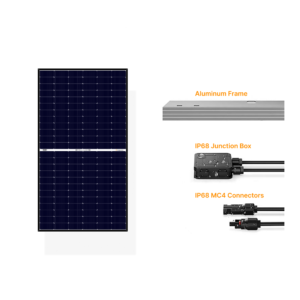
Mechnaical Properties
| Length of Module | 2296mm |
| Width of Module | 1134mm |
| Thickness of Frame | 35mm |
| Cell Type | Mono PERC 10BB Half Cut Cell |
| Cell Dimension | 91mmx182mm |
| Front Cover | 3.2mm High Transmission Low Iron Tempered Glass |
| Frame Type | Black Anodized Aluminium Frame |
| Junction Box | IP68 |
| Weight | 29.5 Kg |
| Connector | MC4 IP68 |

Warranty
| Product Warranty** | 10 years |
| Performance Warranty** | Linear Power Warranty for 25 years with 2.5% for 1st year degradation and 0.50% from 2 years to 25 years |
Additional Information
| Dimensions Length x Width x Height | 2296mm x 1134mm x 35mm |
| Warranty | 25 Years |
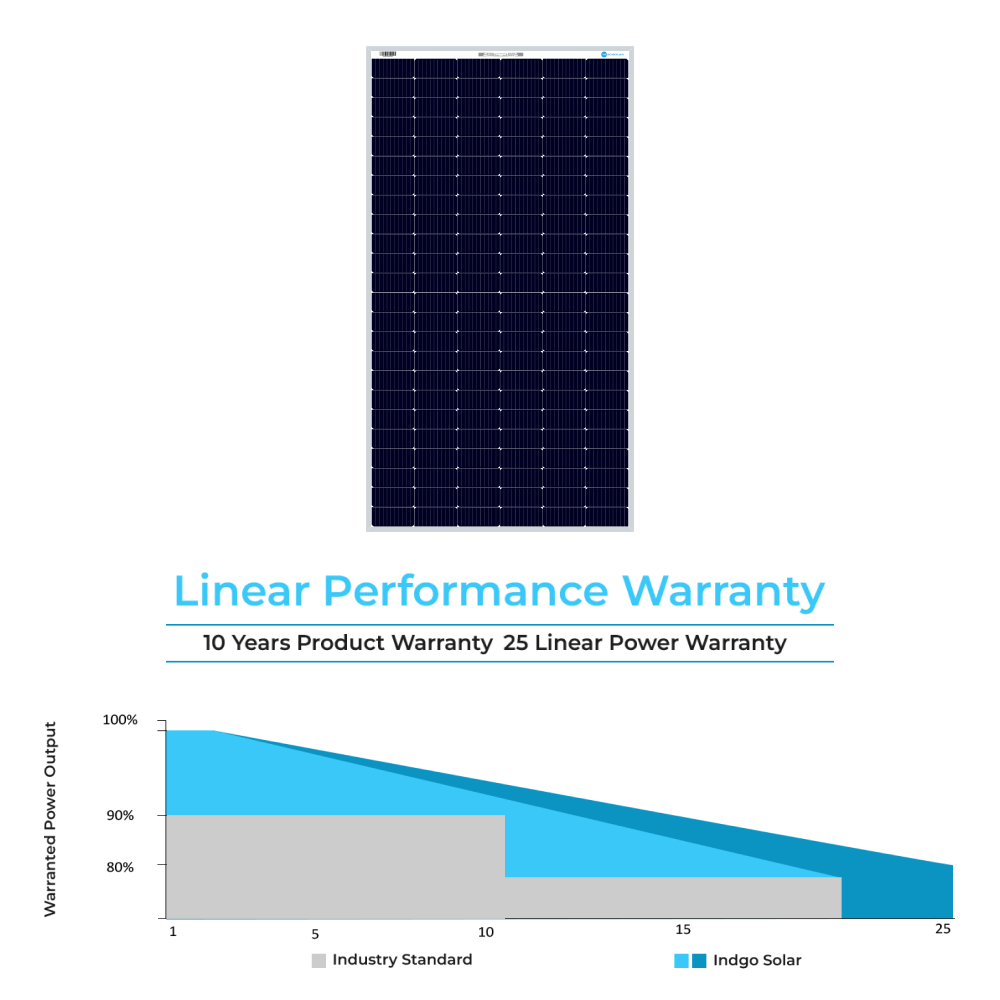

Warranty
| Product Warranty** | 10 years |
| Performance Warranty** | Linear Power Warranty for 25 years with 2.5% for 1st year degradation and 0.50% from 2 years to 25 years |
Additional Information
| Dimensions Length x Width x Height | 2296mm x 1134mm x 35mm |
| Warranty | 25 Years |

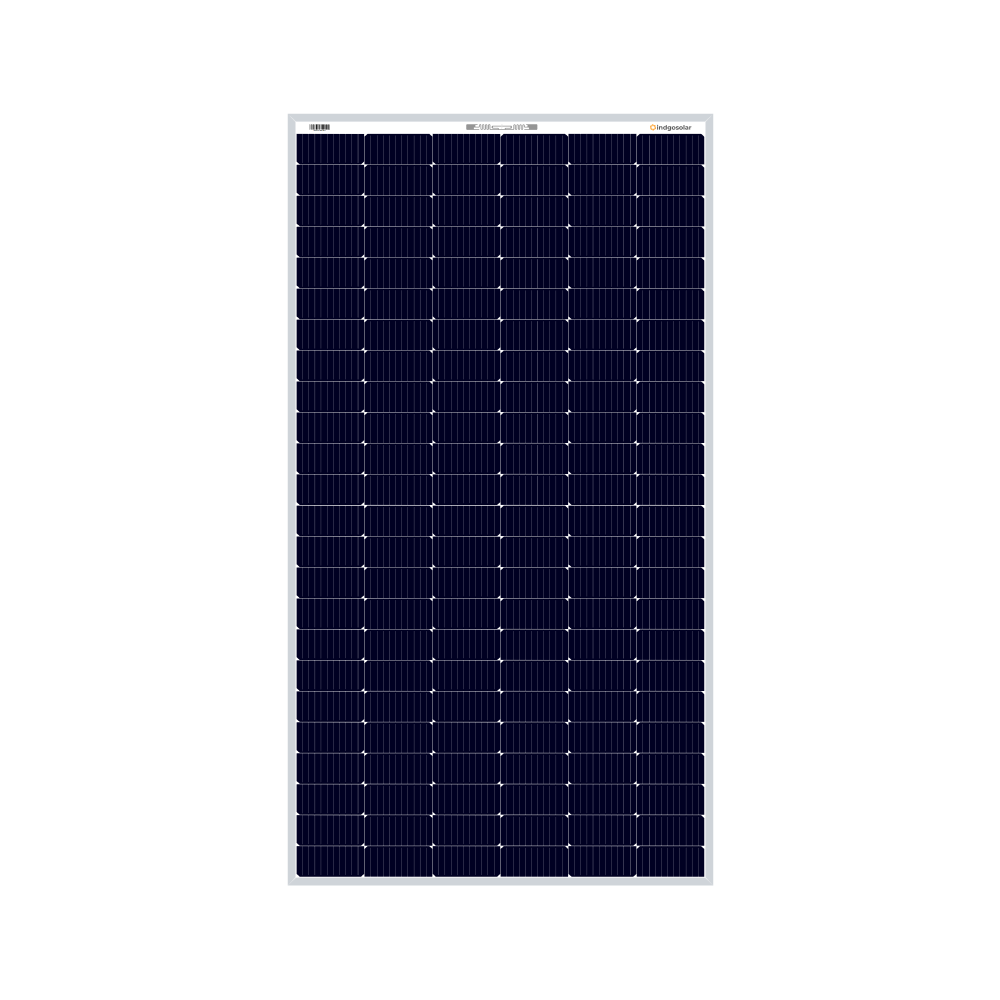
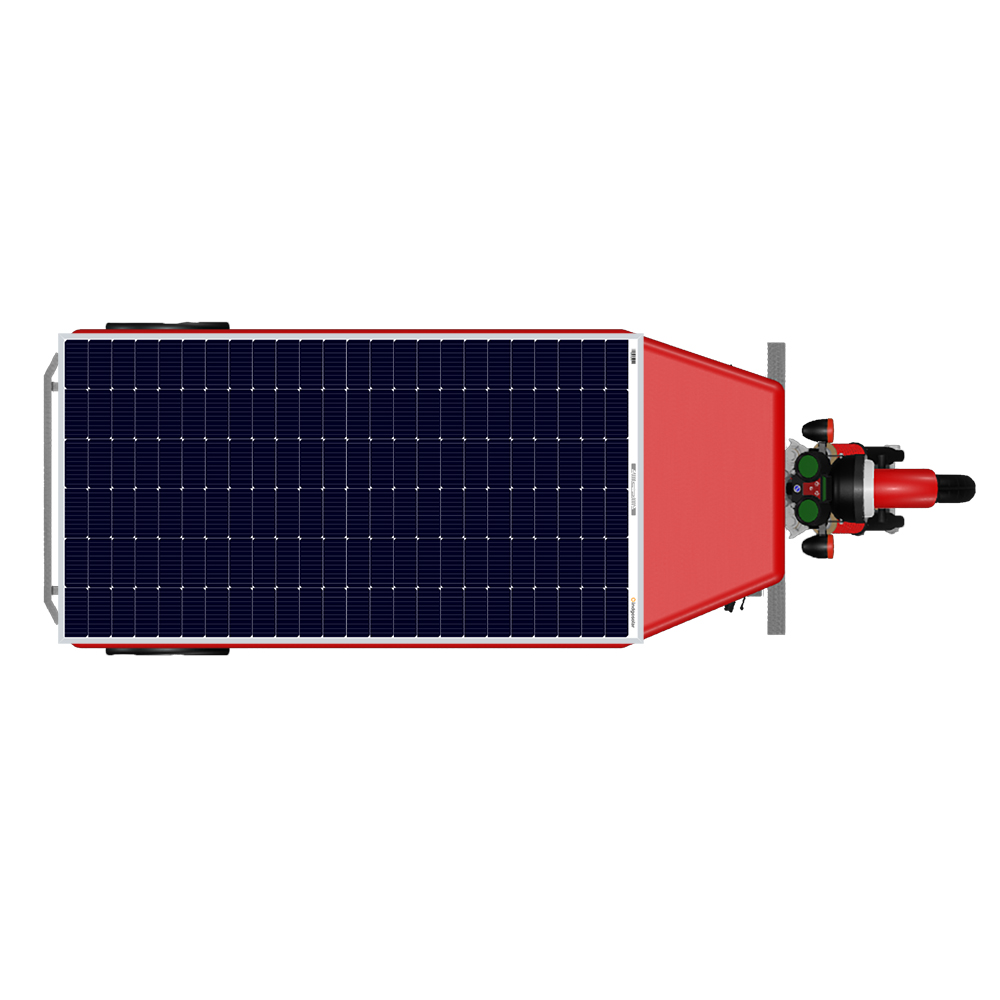

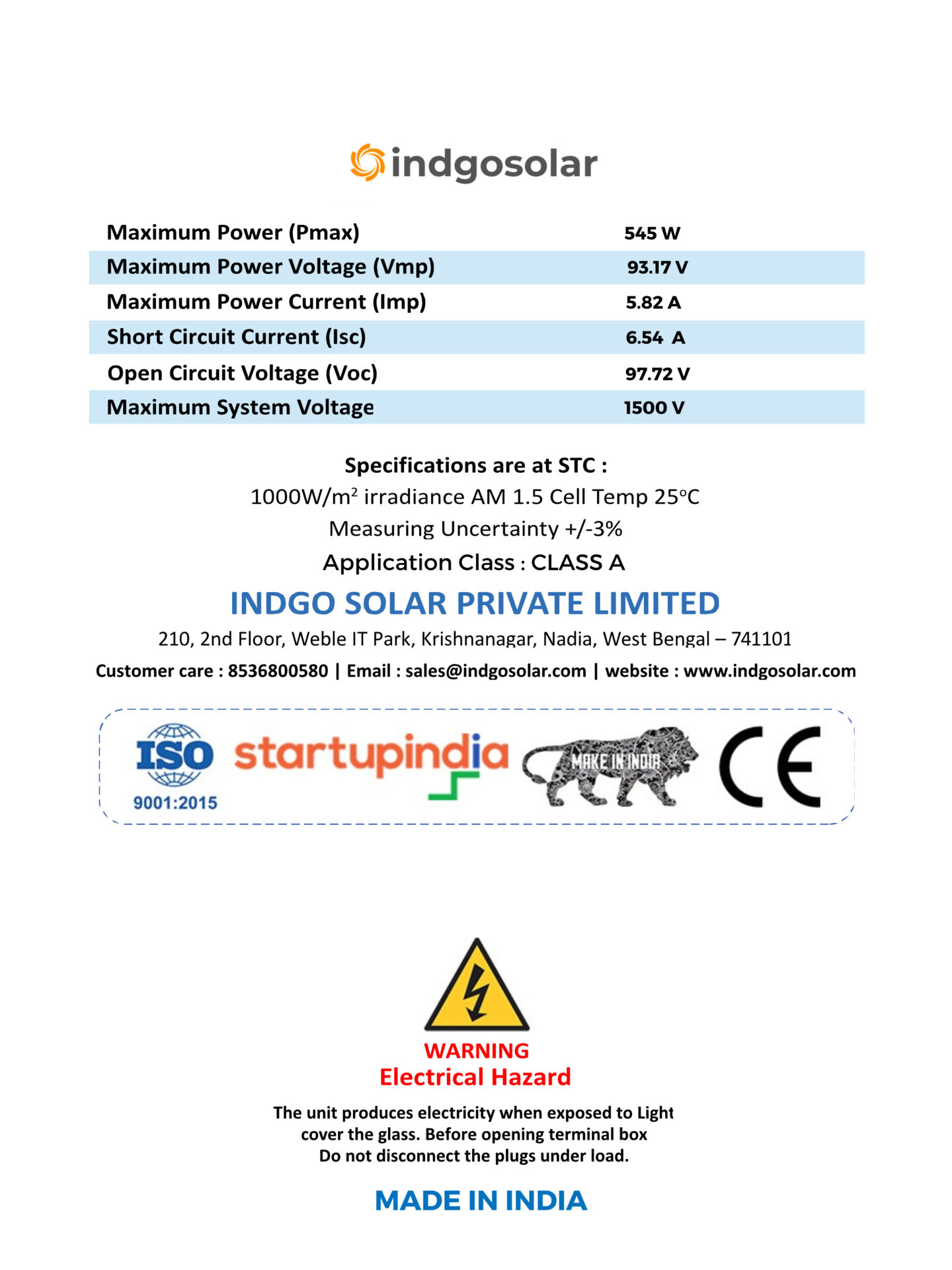
Reviews
There are no reviews yet.